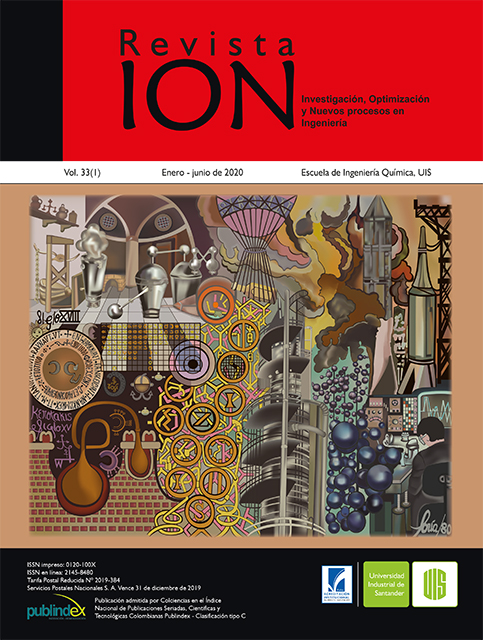Use of chamotte post-consumption in the formulation of a refractory paste as a replacement of the aluminum oxide
Published 2020-06-30
Keywords
- Post-Consumption Chamotte,
- Refractories,
- Pyrometric Cone Equivalent Dilatometry
How to Cite
Abstract
The development of refractory ceramic materials has been derived from industries that use high temperatures in their processes. The use of post-consumer material for the formulation of refractory pastes is of interest for sustainable development with economic and environmental impact. The objective of this work is to study the effect of the addition of post-consumption chamotte in a refractory paste as an alumina replacement. The chamotte was obtained from porous refractory insulating bricks that fulfilled their life cycle in the ceramic industry. These were subjected to a comminution process using a ball mill until it was passed through 50 mesh. The chamotte was characterized by X-ray diffraction. Four mixtures were formulated and sintered at 1600 °C. Pyrometric cone (ASTM C-24), density and porosity (ASTMC-20), linear contraction and dilatometry were evaluated. The results indicate that the addition of postconsumption chamotte reduces the pyrometric cone of the refractory obtained, the sample that does not contain chamotte has a cone over 36 and the sample of higher content has a cone 32, which are suitable for use as a refractory brick. With the addition of chamotte, the density of the samples was increased and the porosity and contraction decreased. Finally, in the dilatometry test, changes in the dilatometric curve are evidenced, which are attributed to a greater formation of liquid phase and fines due to the contribution made by silica and K2O present in the chamotte.
Downloads
References
[2] Nakamura Y, Hirai N, Tsutsui Y, Uchinokura K, Tamura SI. Recycling of refractories in the steel industry. JAST. 1999; D693-D700.
[3] Segadães AM. Use of phase diagrams to guide ceramic production from wastes. Adv. Appl. Ceram. 2006;05(1):46-54.
[4] Sadik C, El Amrani IE, Albizane A. Recent advances in silica-alumina refractory: A review. J. Asian Ceram. Soc. 2014;2(2):83-96.
[5] Ishizaki K, Komarneni S, Nanko M. Porous Materials: Process technology and applications. United States: Springer US; 2013.
[6] Fang H, Smith JD, Peaslee KD. Study of spent refractory waste recycling from metal manufacturers in Missouri. Resour., Conserv. Recycl. 1999;25(2):111-124.
[7] Caniglia S, Barna GL. Handbook of industrial refractories technology: principles, types, properties and applications. United States: Noyes Publications; 1992.
[8] Carter CB, Norton MG. Ceramic materials: science and engineering. United States: Springer; 2007.
[9] Dana K, Sinhamahapatra S, Tripathi HS, Ghosh A. Refractories of alumina-silica system. Trans. Indian Ceram. Soc. 2014;73(1):1-13.
[10] Aramaki S, Roy R. Revised phase diagram for the system Al2O3—SiO2. J. Am. Ceram. Soc. 1962;45(5):229-242.
[11] Bauleke MP. How to solve the problems of body cracking and glaze popping in stoneware bodies. Bull. - Kans. Geol. Surv. 1977;(211):23-27.
[12] Rossini L, Mennucci L, Figueras R. Dilatometría de arcillas refractarias argentinas. Bol. Soc. Esp. Ceram. 1970;9(5):507-538.
[13] Lee WE, Souza GP, McConville CJ, Tarvornpanich T, Iqbal Y. Mullite formation in clays and clay-derived vitreous ceramics. J. Eur. Ceram. Soc. 2008;28(2):465-471.
[14] Fayyad SM, Al-Marahleh, GS, Abu-Ein, SQ. Improvement of the Refractoriness under Load of Fire-Clay Refractory Bricks. Adv. Theor. Appl. Mech. 2012;5(4):161-72.
[15] Rodríguez GP, Quintero JP, Tovar MG. Determinación Experimental de la Conductividad Térmica Efectiva en Bloques Extinguidos de Arcilla Roja. (Experimental Determination of the Eective Thermal Conductivity in the Extruded Red Clay Bricks.). CeD [Internet]. 2014;5(1):15-20.
[16] Bertini J. Notas técnicas. Calidad de los refractarios. Revista IDIEM. 1965;4(3):189-211.


